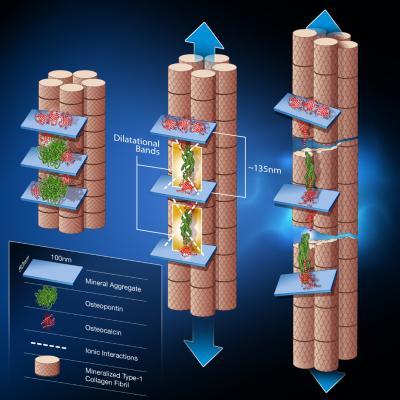The little-understood protein osteocalcin plays a significant role in the strength of our bones, says a new paper, and the findings could lead to new strategies for fighting osteoporosis and lowering the risk of bone fracture.
Who came up with that? Biologists? Doctors? No, engineers.
Their study details how fractures in healthy bones begin with the creation of incredibly tiny holes, each measuring only about 500 atoms in diameter within the bone's mineral structure. In the case of a slip, trip, or fall, the force of the impact on a bone physically deforms a pair of joined proteins, osteopontin and osteocalcin, and results in the formation of nanoscale holes called dilatational bands.
These dilatational bands, function as a natural defense mechanism, and help to prevent further damage to the surrounding bone. However, if the force of the impact is too great, or if the bone is lacking osteopontin, osteocalcin, or both - the bone will crack and fracture. This is the first study to show fracture at the level of bone's nanostructure.
Long known but little understood, the protein osteocalin has been produced by and present in animal bones since before the dawn of humanity. Recently, abnormalities in ostoecalcin production have been associated with type 2 diabetes as well as problems in reproductive health. Vashishth's new study, however, is the first to explain the structural and mechanical importance of osteocalcin in bone.

Dilatational bands function as a natural defense mechanism and help to prevent further damage to the surrounding bone. However, if the force of the impact is too great--or if the bone is lacking osteopontin, osteocalcin, or both--the bone will crack and fracture, as seen on the right. Findings of the study could lead to new strategies and therapeutics for fighting osteoporosis and lowering the risk of bone fracture. Credit: Rensselaer/Vashishth
"This study is important because it implicates, for the first time, the role of osteocalcin in giving bone the ability to resist fracture," said Deepak Vashishth, head of the Department of Biomedical Engineering at Rensselaer. "Since osteocalcin is always the point of fracture, we believe that strengthening it could lead to a strengthening of the overall bone."
Now that osteocalcin is known to participate in bone fracture, new strategies for strengthening the bond between osteocalin and osteopontin can be investigated. Augmenting the body's natural supply of osteocalcin, for example, could be one possible strategy for treating osteoporosis and other conditions leading to increased fracture risk.
Osteocalin must be in its carboxylated form to get absorbed into bone, and the protein is carboxylated by vitamin K. Vashishth said future studies could investigate the relation between vitamin K intake, osteocalcin, and bone strength.
"Currently, all of the advice for treating osteoporosis is related to calcium. We believe there's more to the story than just calcium, and the results of this new study raise an important question about vitamin K. Leafy green vegetables are the best source of vitamin K—wouldn't it be great if eating spinach and broccoli was not only healthy, but also good for your bones? We plan to investigate this link in future," Vashisth said.





Comments